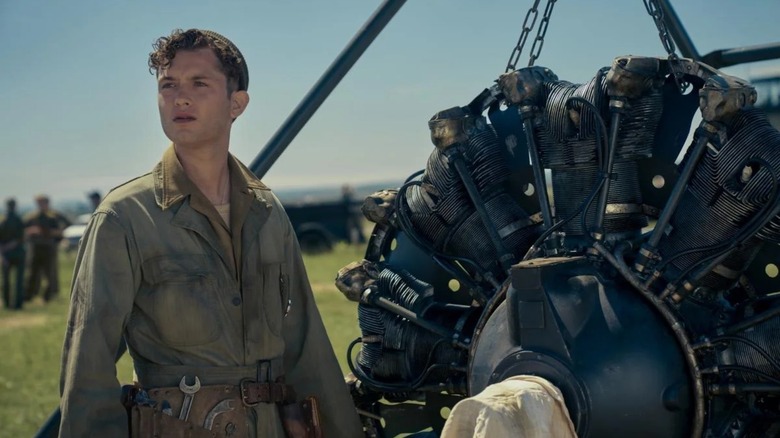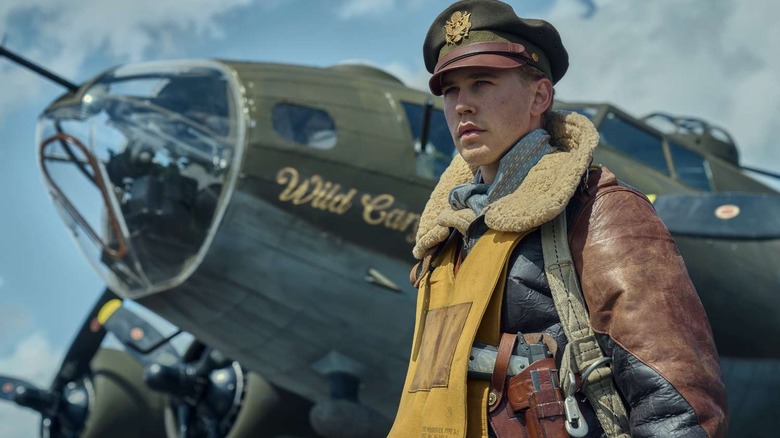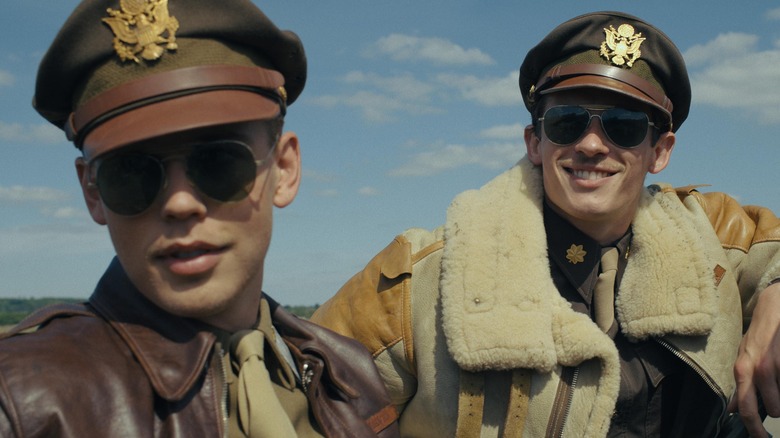Is Apple TV's Masters Of The Air Historically Accurate?
The World War II drama series "Masters of the Air," created by John Shiban and John Orloff and currently airing on AppleTV+, takes place in 1943 and follows USAAF majors as they are transferred to England to aid the Allied war effort. Austin Butler plays Major Gale Cleven and Callum Turner plays Major John Egan, both real-life USAAF pilots, and the series is based on the biographical book "Masters of the Air: America's Bomber Boys Who Fought the Air War Against Nazi Germany," written by Donald L. Miller.
"Masters of the Air" was also co-produced by Tom Hanks and Steven Spielberg, who previously oversaw the WWII drama shows "Band of Brothers" and "The Pacific" after collaborating on the 1998 film "Saving Private Ryan." These two men love harrowing tales of soldiers and seem hellbent on recreating the 1940s soldiers' experience on film as accurately as possible. Hanks also wrote and starred in the WWII thriller "Greyhound," which was especially replete with technical details, its cameras lingering over control panels and strategy maps as if they were the sexiest thing imaginable. Verisimilitude is the word of the day.
The creative team and the concurrent prestige of "Masters of the Air," then, might lead a viewer to assume that it is 100% historically and technically accurate. But just how accurate is it, according to the experts? USA Today recently spoke with the book's author, Donald L. Miller, a Ph.D.-holding professor from the University of Maryland, and he ran down what "Masters of the Air" got right and what it fudged for the sake of drama.
What's based on real life?
Miller noted that all the main characters from "Masters of the Air" are based on real people. In addition to the parts played by Butler and Callum, Barry Keoghan plays Lieutenant Curtis Biddick, Anthony Boyle plays Lieutenant Harry Crosby, Nate Mann plays Major Robert Rosenthal, and Sawyer Spielberg (Steven's son) plays Lieutenant Roy Claytor. These were all real pilots. Miller was already experienced in transposing soldiers' lives to the screen, as his book "D-Days in the Pacific" was adapted into the 2010 drama "The Pacific." The author noted, however, that time has passed and history continues to recede from us. He said:
"The big difference between making this and 'The Pacific' is that back then, a lot of those vets were still alive and the actors could call them, or we'd have them on set, and they'd tell us what really happened. [...] With this, I was practically the only one who had known or interviewed many of these real vets. So the actors would come to me, and I'd help best I could."
Miller also noted that while British pilots and American pilots did get along for the most part, the spikiness and resentment seen on "Master of the Air" was quite real. The American pilots, he noted, were better funded, and carried with them a "sexy" image. Miller continued:
"It was mostly over the fact that the Brits thought American flyboys were pampered. [...] The Americans were much better paid, they wore snappy uniforms, seemed a little more dashing and in the competition for women they seemed to have the advantage. Money in the pockets, Sinatra records, the latest popular culture, foreign accents, these dashing Americans, the exoticism of it."
German POW camps
There are scenes in "Masters of the Air" wherein several characters are apprehended by the Nazis and thrown into POW camps. While inside, the prisoners have a strange amount of leeway, having the opportunity to build radios in secret. This seems more like a scene out of "The Great Escape" than a hard-edged depiction of real life. But as it so happens, POWs actually did have a lot of privacy and leeway in German POW camps, and such elaborate constructions were possible under the circumstances. Miller continued:
"Sure, a lot of Jewish (American) soldiers were worried about being hauled out of the barracks and shot, but it only happened if you tried to escape. [...] By and large you were left alone under your commanders to organize your day. Mostly they tried to mess with the goons, as they called them, making plans to get out like you saw in 'The Great Escape' or 'Hogan's Heroes.'"
Astonishing. It wasn't until the end of the war, Miller said, that POWs became nervous. The SS began taking over certain prisons, and they were a lot less predictable than the usual Nazi guards.
Miller also noted that the planes were, in real life, as dangerous as they looked on the show. A person could puncture the skin of these planes with a screwdriver, and Nazi planes would often target the pilots specifically.
The part that was missing from "Masters" that Miller wishes they had time to include was the story of Swiss soldiers. Evidently, there were Swiss officials with Nazi ties, and the storytellers "were hoping to tell the story of airmen who suffered in these Swiss camps," Miller said. "The guys really felt helpless, it was a horrible and unknown part of the war, but we couldn't work it in."


